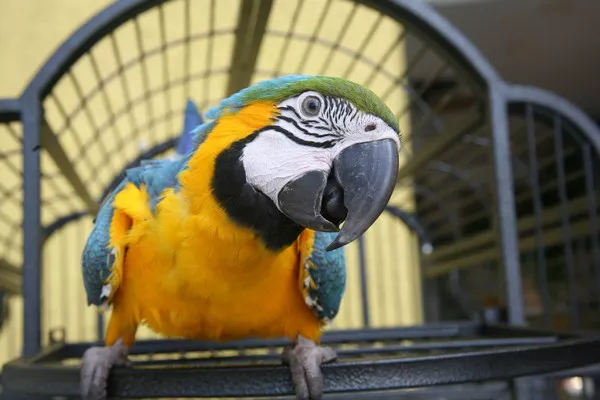Conures are colorful, lively, and intelligent birds that make wonderful pets for the right owner. However, just like any other pet, they require proper care and attention to thrive. One of the most important aspects of a conure’s overall health is its beak. A healthy beak is essential for eating, climbing, vocalizing, and overall well-being. Understanding what a healthy beak looks like, how to recognize signs of problems, and how to take care of it is vital for any conure owner.
This article explores the characteristics of a healthy conure beak, common beak-related issues, how to prevent these issues, and what to do if you notice anything unusual.
What Is the Beak’s Function?
Before diving into the details of what a healthy beak looks like, it’s essential to understand the beak’s role in a conure’s daily life. A conure’s beak is not just a tool for eating; it is also an essential part of their interaction with their environment. The beak helps with:
Eating and Drinking: A conure uses its beak to break food into manageable pieces, crack seeds, and scoop up water.
Climbing: Conures often use their beaks in conjunction with their feet to help them climb and balance.
Social Interaction: The beak plays a role in the bird’s social behavior, whether it’s preening other birds or engaging in playful interactions.
Vocalization: Conures, like all parrots, use their beaks in the process of vocalization, although the actual sound comes from their syrinx.
Characteristics of a Healthy Conure Beak
A healthy beak is a critical part of your conure’s overall health, and it should exhibit several distinct characteristics. Here’s what to look for:
1. Color
A conure’s beak should appear bright, vibrant, and uniform in color. The exact color varies by species, but it generally ranges from pale ivory to dark gray, depending on the individual bird. Some species, like the Sun Conure, have a bright orange or red beak, while others, like the Green Cheek Conure, have darker tones.
Normal Color: Healthy conure beaks are typically uniform in color with no patches of discoloration, such as yellow, white, or brown.
Signs of Concern: If you notice discoloration like black spots, a whitish color, or dullness, it could indicate issues such as fungal infections, injury, or metabolic problems.
2. Shape
The beak of a healthy conure should have a natural, well-defined shape. It should be symmetrical, with the upper mandible (top part) slightly overhanging the lower mandible (bottom part), forming a gentle curve.
Normal Shape: Both the top and bottom beak should align properly without any noticeable misalignment. The top mandible should have a gentle curve, and the lower mandible should fit smoothly underneath it.
Signs of Concern: If the beak appears deformed, overgrown, or curved abnormally, it may indicate issues such as malnutrition, injury, or a lack of proper beak wear.
3. Smoothness and Texture
A healthy beak is smooth and free from rough patches or lesions. It should not have scabs, cracks, or chips.
Normal Texture: The surface of the beak should be smooth and even, without any visible rough spots.
Signs of Concern: Dryness, cracks, peeling, or a rough texture may signal dehydration, injury, or a vitamin deficiency. These conditions require attention from a veterinarian.
4. Size
The size of a conure’s beak should be appropriate to its body size. If you notice that your conure’s beak is too large or small for its size, this could be a sign of health problems.
Normal Size: A healthy conure’s beak should be proportional to its head and body.
Signs of Concern: A beak that appears abnormally large or small could point to developmental issues, malnutrition, or other health problems.
5. Functionality
A healthy beak should be functional and capable of handling the bird’s everyday needs, such as eating, climbing, and preening. The beak should be able to open and close easily, without stiffness or pain.
Normal Functionality: The beak should move freely when the bird is eating or manipulating objects. It should also be strong enough to break open seeds and nuts.
Signs of Concern: Difficulty moving the beak, chewing, or interacting with objects might indicate joint issues, arthritis, or injury. This requires immediate attention from a veterinarian.
Common Beak Issues in Conures
While conures are generally healthy birds, they can develop a variety of beak-related issues. These can range from minor cosmetic problems to more severe health concerns that require veterinary intervention.
1. Beak Overgrowth (Hypertrophy)
Beak overgrowth is one of the most common problems in pet birds, including conures. This condition occurs when the beak grows longer than usual, often curving or becoming malformed.
Causes: Beak overgrowth can be caused by nutritional deficiencies, lack of proper chewing activity, injury, or metabolic disorders.
Signs: The beak may become excessively long or curved, making it difficult for the bird to eat or drink properly. You may also notice the bird not chewing as much or avoiding food.
Treatment: If your bird has an overgrown beak, it’s important to take it to an avian vet. In some cases, the vet may trim the beak, but long-term solutions usually involve changes to the bird’s diet and environment to encourage proper wear.
2. Beak Deformities
Some conures are born with beak deformities. These deformities may not always be noticeable at first but can affect the bird’s ability to feed, preen, or interact with its surroundings.
Causes: Beak deformities can be genetic, due to malnutrition, or caused by environmental factors.
Signs: A crooked, asymmetrical, or split beak is a typical sign of a deformity. Birds with severe beak deformities might have difficulty eating or drinking.
Treatment: There is no way to reverse genetic beak deformities, but an avian vet can help by trimming the beak regularly and offering dietary and environmental modifications to ensure the bird can still function normally.
3. Scaly Face (Scaly Beak)
Scaly face, also known as scaly beak syndrome, is a common issue among conures and other parrots. It is caused by a parasitic infection from the Cnemidocoptes mite, which burrows into the skin around the beak.
Causes: Scaly face is caused by a mite infestation that leads to crusty, scaly patches on the beak and face.
Signs: You may notice yellow, white, or grayish crusts around the beak, eyes, or cere (the fleshy area around the beak). The bird may scratch its face or rub it against surfaces to alleviate discomfort.
Treatment: Scaly face is treatable with anti-parasitic medications, which a veterinarian can prescribe. In addition, cleaning the bird’s environment regularly and improving its overall hygiene can help prevent future outbreaks.
4. Beak Injuries
Beak injuries are not uncommon in pet conures, especially those who are very active or engage in rough play. Injuries can occur from accidents, fighting, or even from being exposed to sharp objects in the cage.
Causes: Beak injuries can happen when a conure bumps into sharp objects, fights with another bird, or falls from a height.
Signs: If your conure has a beak injury, you might notice bleeding, swelling, or changes in the shape of the beak. The bird may also be reluctant to eat or drink.
Treatment: For minor injuries, the bird’s beak may heal naturally with time and proper care. However, more serious injuries require immediate veterinary attention. Beak injuries can lead to infections if not properly treated.
5. Malnutrition and Vitamin Deficiencies
A lack of proper nutrition is one of the most common causes of beak problems in conures. Without the right balance of vitamins, minerals, and other nutrients, a conure may develop weakened, deformed, or discolored beaks.
Causes: Malnutrition, usually caused by a poor diet lacking in essential vitamins like Vitamin A and calcium, can lead to weakened beaks. Vitamin A deficiency is particularly common in pet birds.
Signs: A dull, rough, or brittle beak, along with lethargy and poor feather quality, can be signs of malnutrition.
Treatment: Proper nutrition is key to preventing and treating vitamin deficiencies. A balanced diet with high-quality pellets, fresh fruits, vegetables, and the occasional seed will support your conure’s overall health. If you suspect a deficiency, consult an avian veterinarian for recommendations on supplements.
6. Fungal or Bacterial Infections
Fungal or bacterial infections in the beak can occur, leading to discolored patches, swelling, and discharge around the beak area.
Causes: Infections often occur as a result of injury, poor hygiene, or a weakened immune system.
Signs: Infected beaks may show signs such as swelling, redness, pus, or unusual discharge around the beak. The bird might have difficulty eating or drinking due to pain.
Treatment: A veterinarian will need to diagnose and treat infections with the appropriate medications, such as antibiotics or antifungal treatments. Prompt treatment is essential to prevent the infection from spreading or causing permanent damage to the beak.
Preventing Beak Problems in Conures
While some beak issues may be unavoidable, many can be prevented with proper care and attention. Here are some tips to help ensure that your conure’s beak stays healthy:
Provide a Balanced Diet: A nutritious diet that includes fresh vegetables, fruits, high-quality pellets, and occasional seeds is essential for maintaining a healthy beak.
Encourage Natural Chewing: Conures need to chew to keep their beaks properly worn down. Provide appropriate toys such as wooden blocks, leather, or bird-safe branches to encourage this natural behavior.
Regular Veterinary Checkups: Routine vet visits can help catch any potential issues early. Your vet will also provide guidance on nutrition and care.
Maintain Proper Hygiene: Keeping your conure’s cage and environment clean helps prevent infections, such as scaly face or fungal growths.
Conclusion
A healthy beak is an essential part of your conure’s overall health and well-being. By regularly observing the beak’s appearance, monitoring your bird’s behavior, and seeking professional help when needed, you can help ensure that your conure stays happy and healthy. Whether it’s noticing signs of beak overgrowth, addressing scaly face, or maintaining a balanced diet, being proactive is the key to preventing and addressing beak problems.
By taking good care of your conure’s beak and ensuring they have the proper environment and nutrition, you’re giving them the best chance at a long, healthy, and happy life. Always remember that the beak is not only a tool for eating, but a crucial element of your bird’s interaction with the world around it. Keep an eye on this important aspect of their health, and they’ll continue to bring joy and vibrance to your life for many years to come.
Related Topics:























